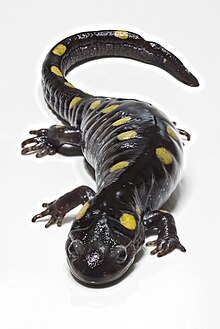
Back Salamander Afrikaans Caudata AN سلمندر Arabic سلمندر ARZ Caudata AST Suda-quruda yaşayan quyruqlular Azerbaijani Salamander BBC Хвастатыя земнаводныя Byelorussian Хвастатыя земнаводныя BE-X-OLD Опашати земноводни Bulgarian
| Salamanders | |
|---|---|

| |
| Spotted salamander, Ambystoma maculatum | |
| Scientific classification | |
| Domain: | Eukaryota |
| Kingdom: | Animalia |
| Phylum: | Chordata |
| Class: | Amphibia |
| Clade: | Caudata |
| Order: | Urodela Duméril, 1806 |
| Suborders | |

| |
| Native distribution of salamanders (in green) | |
Salamanders are amphibians. They are the order Caudata (or Urodela). There are about 500 different species.
Salamanders live in water and on land, and look rather like lizards, with four legs and a tail. They hatch as larvae from eggs in the water. At that stage, they have gills that stick out.
Most salamanders live on land when they are adults, after their change of shape (metamorphosis). On land, salamanders live in moist habitats. Their method of respiration varies. Some salamanders stay in the water, but look like adults. These are called newts. Some salamanders retain gills into sexual maturity, such as the Axolotl. This process is called neoteny.
Often, salamanders may have a chemical defence to predators; they are poisonous to eat. In this case, they will have warning colouration. Otherwise, if not poisonous, they will usually have camouflage.
Salamanders are the only tetrapods able to regenerate limbs, as well as other body parts.
- ↑ Anderson, J. S. (2012). "Fossils, molecules, divergence times, and the origin of Salamandroidea". Proceedings of the National Academy of Sciences. 109 (15): 5557–5558. Bibcode:2012PNAS..109.5557A. doi:10.1073/pnas.1202491109. PMC 3326514. PMID 22460794.